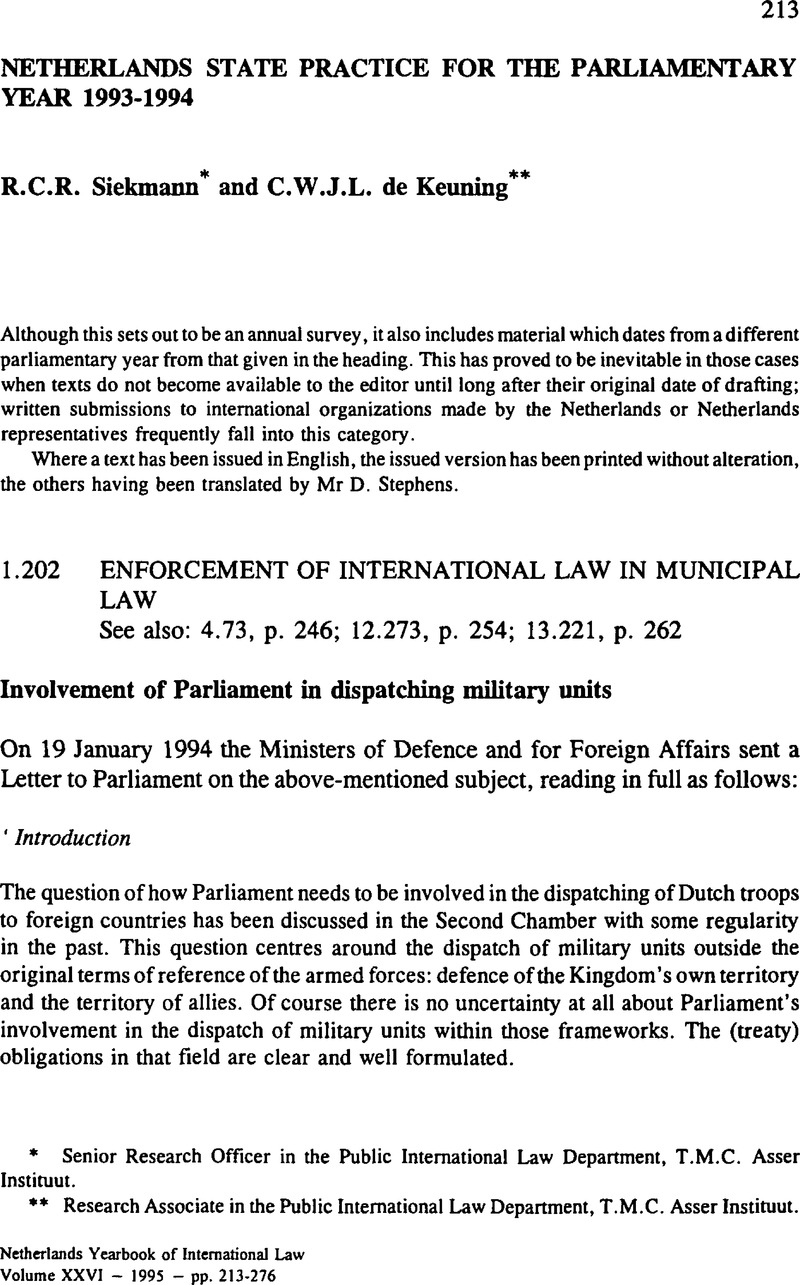No CrossRef data available.
Published online by Cambridge University Press: 07 July 2009

1. Bijl. Hand. II 1991/92 – 22300 X No. 88.
2. See 25 NYIL (1994) p. 362 et seq.
3. Bijl. Hand. II 1978/79 – 15441. The UN operation in Korea is not considered in this context because of its very specific and one-off character.
4. Bijl. Hand. II 1978/79 – 15441 No. 7.
5. Bijl. Hand. II 1980/81 – 16521, Stb. 1988 No. 539.
6. Bijl. Hand. II 1987/88 – 16521 No. 13.
7. The terminology currently used is ‘consistent with the War Powers Resolution’.
8. See most recently The Conduct of the Persian Gulf War, Final Report to Congress (pursuant to title V of the Persian Gulf Conflict Supplemental Authorization and Personnel Benefits Act of 1991 (Public Law 102–25), Department of Defense Publication, April 1992; this form of reporting takes place under the American budgeting system.
9. Interim provision Bundesverfassungsgericht of 23 June 1993, 2 BVG 17/93.
10. Bijl. Hand. II 1985/86 – 15621 No. 5.
11. Bijl. Hand. II 1990/91 – 21664 No. 25.
12. These sections (such parts as are relevant) read as follows:
Section 90
The Government promotes the development of the international system of law.
Section 96
1. The Kingdom will not declare war without the prior agreement of the States-General.
2 …
Section 97
All Dutch subjects who are able to do so, have a duty to contribute to the maintenance of the independence of the State and to the defence of its territory.
Section 98
1. The armed forces exist to protect the interests of the State and are made up of voluntary and conscripted service personnel.
2. The Government has supreme command over the armed forces.
13. See also the recommendation of the Council of State, Bijl. Hand. II 1985/86 – 19290 B.
14. See also the note Juridischeaspecten van de Golfcrisis, Bijl. Hand. II 1990/91 – 21664, No. 25.
15. Cf., Kortman, C.A.J.M., Constitutioneel recht (1990) p. 198.Google Scholar
16. Akkermans, P.W.C. and Koekkoek, A.K., eds., De Grondwet, een artikelgewijs commentaar, 2nd. edn. (1992) p. 657.Google Scholar
17. Section 43 of the Charter indicates the manner in which agreements with the UN can be entered into where military units and/or facilities are to be placed at the disposal of the UN to uphold international peace and security. Subsection 3 of this section places the initiative for such agreements in the hands of the Security Council. The section lays down that the agreements referred to here are agreements which must be ratified by the Member States in accordance with their constitutional obligations. By Dutch standards this means a treaty which is subject to the approval of Parliament.
18. UN Doc. A/47/277 of 17 June 1992.
19. Trb. 1982 No. 61.
20. Bijl. Hand. II 1993/94 – 23591 No. 1
21. See 22 NYIL (1991) p. 254 et seq.
22. Bijl. Hand. I/II 1993/94 – 23730 (R 1503) No. 1 pp. 2–4.
23. Bijl. Hand. II 1993/94 – 19637 No. 100.
24. Bijl. Hand. II 1993/94 – 22475 No. 6.
25. See 22 NYIL (1991) p. 267 et seq.
26. Bijl. Hand. II 1993/94 – 23588 No. 3.
27. See 22 NYIL (1991) p. 267 et seq.
28. Bijl. Hand. II 1993/94 – 23807 No. 3.
29. Bijl. Hand. II 1993/94 – 23400 VI No. 53.
30. See 24 NYIL (1993) p. 246 et seq.
31. Krikke, A., ‘De rechtsgrond van de bewijsuilsluiting in strafeaken’, in: Bij deze stand van zaken (1983).Google Scholar
32. Swart, A.H.J., ‘DeNederlandse strafrechtspleging en het internationale recht’, in: Corstens, G.J.M., ed., Internationalisering van het strafrecht (1986) p. 61.Google Scholar
33. HR 6 March 1990, NJ 1990, 467.
34. Meijers, L.C.M., ‘Waarborgen voor een eerlijke(straf)procedure’ in: Met hoofd en hart (1991) pp. 181–191.Google Scholar
35. Tolken en vertalers in strafiaken (1991), 6th Report of the commitee set up to reasses the Code of Criminal Procedure.
36. ECHR, 20 November 1989; NJ 1990, 245.
37. Asch case, ECHR, 26 April 1991, Series A, No. 203; NJCM-Bulletin (1991) pp. 461–462.
38. ECHR, 24 November 1986; NJ 1988, 745.
39. ECHR, 19 February 1991; Series A, No. 194-A.
40. Corstens, G.J.M., ‘Getuigen op de zitting’, DD (1992) p. 210.Google Scholar
41. The case of Barberá, Messigué and Jabardo, ECHR, 6 December 1988, Series A, No. 146, para. 84.
42. HR 20 December 1926; NJ 1927, 85.
43. Stolwijk, S.A.M., ‘Wachten op Cardot’, DD (1991) pp. 105–110.Google Scholar
44. Bijl. Hand. II 1993/94 – 23672 No. 1 pp. 10–16.
45. Bijl. Hand. II 1993/94 – 23542 No. 3.
46. Bijl. Hand II 1992/93 – 22800 X No. 63.
47. See 24 NYIL (1993) p. 274 et seq.
48. Bijl. Hand. II 1993/94 – 22181 No. 64 pp. 5–8.
49. See 25 NYIL (1994) p. 447 et seq.
50. Bijl. Hand. II 1993/94 – 22181 No. 66.
51. Placed with the Parliamentary Documentation department, for information.
52. Bijl. Hand. II 1993/94 – 23400 X No. 65.
53. Bijl. Hand. II 1993/94 – 22181 No. 80.
54. See 23 NYIL (1992) p. 388 et seq.
55. Bijl. Hand. II 1993/94 – 23400 V No. 79.